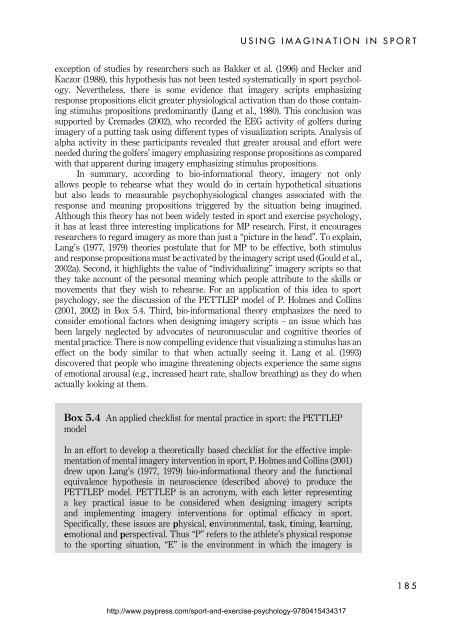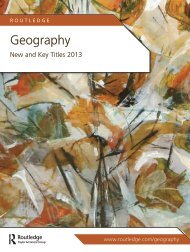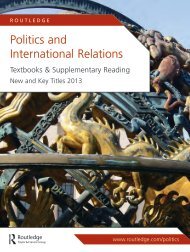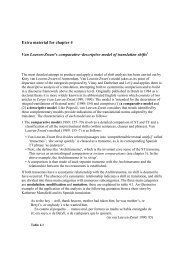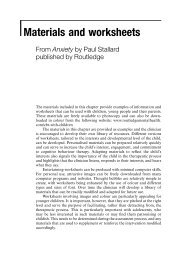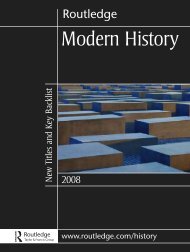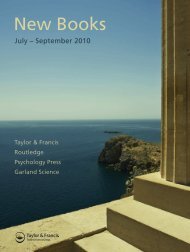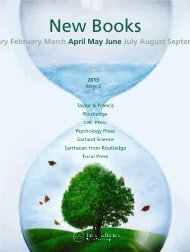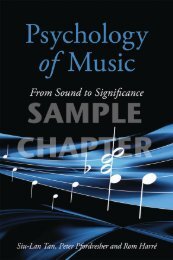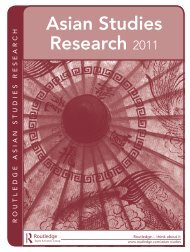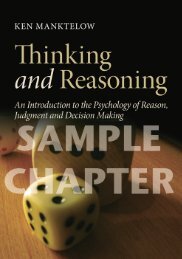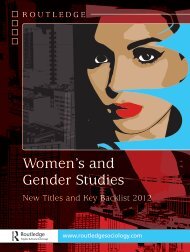Sport and Exercise Psychology: A Critical introduction ... - Routledge
Sport and Exercise Psychology: A Critical introduction ... - Routledge
Sport and Exercise Psychology: A Critical introduction ... - Routledge
Create successful ePaper yourself
Turn your PDF publications into a flip-book with our unique Google optimized e-Paper software.
USING IMAGINATION IN SPORT<br />
exception of studies by researchers such as Bakker et al. (1996) <strong>and</strong> Hecker <strong>and</strong><br />
Kaczor (1988), this hypothesis has not been tested systematically in sport psychology.<br />
Nevertheless, there is some evidence that imagery scripts emphasizing<br />
response propositions elicit greater physiological activation than do those containing<br />
stimulus propositions predominantly (Lang et al., 1980). This conclusion was<br />
supported by Cremades (2002), who recorded the EEG activity of golfers during<br />
imagery of a putting task using different types of visualization scripts. Analysis of<br />
alpha activity in these participants revealed that greater arousal <strong>and</strong> effort were<br />
needed during the golfers’ imagery emphasizing response propositions as compared<br />
with that apparent during imagery emphasizing stimulus propositions.<br />
In summary, according to bio-informational theory, imagery not only<br />
allows people to rehearse what they would do in certain hypothetical situations<br />
but also leads to measurable psychophysiological changes associated with the<br />
response <strong>and</strong> meaning propositions triggered by the situation being imagined.<br />
Although this theory has not been widely tested in sport <strong>and</strong> exercise psychology,<br />
it has at least three interesting implications for MP research. First, it encourages<br />
researchers to regard imagery as more than just a “picture in the head”. To explain,<br />
Lang’s (1977, 1979) theories postulate that for MP to be effective, both stimulus<br />
<strong>and</strong> response propositions must be activated by the imagery script used (Gould et al.,<br />
2002a). Second, it highlights the value of “individualizing” imagery scripts so that<br />
they take account of the personal meaning which people attribute to the skills or<br />
movements that they wish to rehearse. For an application of this idea to sport<br />
psychology, see the discussion of the PETTLEP model of P. Holmes <strong>and</strong> Collins<br />
(2001, 2002) in Box 5.4. Third, bio-informational theory emphasizes the need to<br />
consider emotional factors when designing imagery scripts – an issue which has<br />
been largely neglected by advocates of neuromuscular <strong>and</strong> cognitive theories of<br />
mental practice. There is now compelling evidence that visualizing a stimulus has an<br />
effect on the body similar to that when actually seeing it. Lang et al. (1993)<br />
discovered that people who imagine threatening objects experience the same signs<br />
of emotional arousal (e.g., increased heart rate, shallow breathing) as they do when<br />
actually looking at them.<br />
Box 5.4 An applied checklist for mental practice in sport: the PETTLEP<br />
model<br />
In an effort to develop a theoretically based checklist for the effective implementation<br />
of mental imagery intervention in sport, P. Holmes <strong>and</strong> Collins (2001)<br />
drew upon Lang’s (1977, 1979) bio-informational theory <strong>and</strong> the functional<br />
equivalence hypothesis in neuroscience (described above) to produce the<br />
PETTLEP model. PETTLEP is an acronym, with each letter representing<br />
a key practical issue to be considered when designing imagery scripts<br />
<strong>and</strong> implementing imagery interventions for optimal efficacy in sport.<br />
Specifically, these issues are physical, environmental, task, timing, learning,<br />
emotional <strong>and</strong> perspectival. Thus “P” refers to the athlete’s physical response<br />
to the sporting situation, “E” is the environment in which the imagery is<br />
http://www.psypress.com/sport-<strong>and</strong>-exercise-psychology-9780415434317<br />
185


